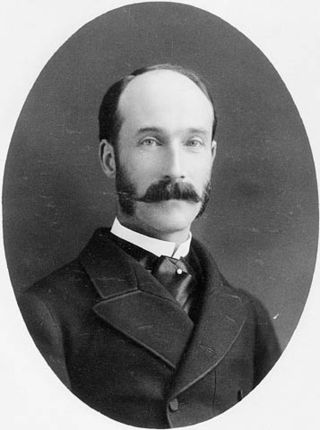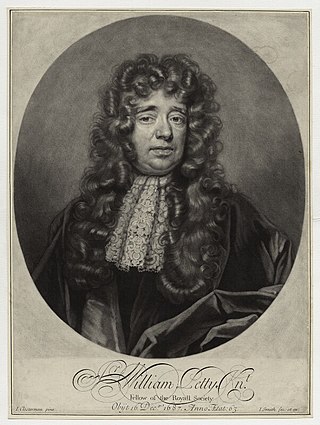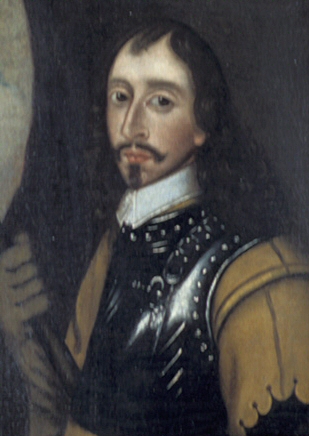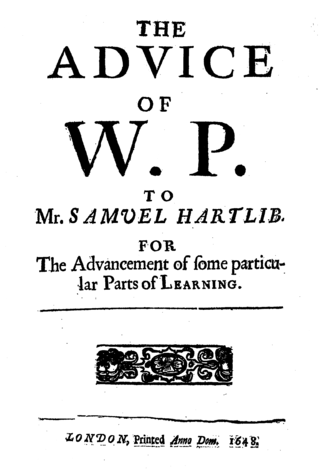Related Research Articles

Henry Charles Keith Petty-Fitzmaurice, 5th Marquess of Lansdowne,, was a British statesman who served successively as Governor General of Canada, Viceroy of India, Secretary of State for War and Secretary of State for Foreign Affairs.

William Petty Fitzmaurice, 1st Marquess of Lansdowne,, was an Anglo-Irish Whig statesman who was the first home secretary in 1782 and then prime minister from 1782 to 1783 during the final months of the American War of Independence. He succeeded in securing peace with America and this feat remains his most notable legacy.

Sir William PettyFRS was an English economist, physician, scientist and philosopher. He first became prominent serving Oliver Cromwell and the Commonwealth in Ireland. He developed efficient methods to survey the land that was to be confiscated and given to Cromwell's soldiers. He also remained a significant figure under King Charles II and King James II, as did many others who had served Cromwell.

Marquess of Lansdowne is a title in the Peerage of Great Britain created in 1784, and held by the head of the Petty-Fitzmaurice family. The first Marquess served as Prime Minister of Great Britain.

Colonel John Hewson, also spelt Hughson, was a shoemaker from London and religious Independent who fought for Parliament and the Commonwealth in the Wars of the Three Kingdoms, reaching the rank of colonel. Considered one of Oliver Cromwell's most reliable supporters within the New Model Army, his unit played a prominent part in Pride's Purge of December 1648. Hewson signed the death warrant for the Execution of Charles I in January 1649, for which he reportedly sourced the headsman, while soldiers from his regiment provided security.

Sir Edward Massey, also spelt Massie, was an English soldier and politician from Cheshire, who sat in the House of Commons at various times between 1646 and 1674. He fought for Parliament in the First English Civil War, when he became famous for his defence of Gloucester. Although he remained loyal during the 1648 Second English Civil War, Massey switched sides following the Execution of Charles I in January 1649, and served under his son Charles II during the Anglo-Scottish war (1650–1652). Badly wounded at Worcester in September 1651, he was captured but managed to escape, and rejoin the exiled Stuart court in the Dutch Republic.

The Down Survey was a cadastral survey of Ireland, carried out by English scientist, William Petty, in 1655 and 1656. It was created to provide for precise re-allocation of land confiscated from the Irish.

Thomas John Hamilton FitzMaurice, 5th Earl of Orkney was a Scottish aristocrat.

Edmond George Petty-Fitzmaurice, 1st Baron Fitzmaurice,, styled Lord Edmond FitzMaurice from 1863 to 1906, was a British Liberal politician. He served as Under-Secretary of State for Foreign Affairs from 1883 to 1885 and again from 1905 to 1908, when he entered the cabinet as Chancellor of the Duchy of Lancaster under H. H. Asquith. However, illness forced him to resign the following year.
Francis Osborne was an English essayist, known for his Advice to a Son, which became a very popular book soon after the English Restoration.
Matthew Thomlinson (1617–1681) was an English soldier who fought for Parliament in the English Civil War. He was a regicide of Charles I. Tomlinson was a colonel of horse (cavalry) in the New Model Army and was one of the officers presenting the remonstrance to parliament in 1647. He took charge of Charles I in 1648, until Charles's execution, but refused to be his judge. He followed Oliver Cromwell to Scotland in 1650.
Lieutenant Colonel Sir William Morton KS was an English judge and politician who sat in the House of Commons in 1640 and from 1663 to 1665. He fought on the Royalist side in the English Civil War.
Colonel James Whitlocke of Trumpington, Cambridgeshire supported the Parliamentary cause in the English Civil War, and was a Member of Parliament during the Interregnum.
Sir Anthony Morgan (1621–1668) was an English Royalist politician and soldier. In the English Civil War he was first a Royalist captain and then in 1646 changed sides and joined the Parliamentary army. He was a captain in Ireton's horse (cavalry) in Ireland in 1649 and had risen to the rank of major by 1662. He was a Member of Parliament for the Irish constituency of Wicklow and Kildare in the parliaments of 1654 to 1658, and represented the Irish constituency of Meath and Louth in 1659. The Lord Protector Oliver Cromwell knighted him in 1656 and after the Restoration, he was also knighted by King Charles II in 1660. He was a commissioner of the English auxiliaries in France and an original member of the Royal Society in 1663.

The Advice to Hartlib was a treatise on education, written by Sir William Petty (1623–1687) in 1647 as a letter to Samuel Hartlib. and published in 1647/8. It was the first printed work by Petty and covers a total of 31 pages.

A Declaration Concerning the newly invented Art of Double Writing was a pamphlet of 6 leaves, written by Sir William Petty (1623-1687) and first published in 1648. It contained information regarding his invention of the "Art of Double Writing", especially a claim for patent rights. It did not contain any information on what his invention exactly was.

The Proceedings between Sankey and Petty is a pamphlet that contains a summary of the controversy that arose between Sir Hierom Sankey and Sir William Petty in the aftermath of the Down Survey. Sankey accused Petty of bribery and fraud. One of the ways in which Petty answered to this accusations was by this pamphlet, that was published in print by Petty in 1659 and covers a total of ten pages.

The Life of Sir William Petty 1623-1687 is a book, written by Lord Edmond Fitzmaurice, and published in 1895. It is a biography of Sir William Petty, the 17th-century scientist, known for his inventions, his charting of large parts of Ireland, in the Down Survey, and his publications on many different topics, like "political arithmetic" and political economy.

The Economic Writings of Sir William Petty is a book with texts, written by William Petty (1623-1687), and published in 1899 by Charles Henry Hull (1864-1936), in two volumes. The Economic Writings were published together with an introduction about the life and work of William Petty, and did also contain Natural and Political Observations upon the Bills of Mortality, by John Graunt.

Reflections upon some Persons and Things in Ireland is an essay, written by Sir William Petty (1620-1687) and published in 1660. It contains a summary of the work carried out by Petty in the so-called Down Survey, and especially a defense against the critics that were cast upon him afterwards. It was a further elaboration of the short pamphlet, titled The Proceedings between Sankey and Petty, that was published by Petty the year before.
References
- Bevan, Wilson Lloyd (1894).
 Sir William Petty: A Study in English Economic Literature . Published as Publications of the American Economic Association, vol. 9, no. 4 (August 1894). Wikisource.
Sir William Petty: A Study in English Economic Literature . Published as Publications of the American Economic Association, vol. 9, no. 4 (August 1894). Wikisource. - Fitzmaurice, Lord Edmond (1895). . London: John Murray – via Wikisource.
- Shaw, William Arthur (1906), The Knights of England: A complete record from the earliest time to the present day of the knights of all the orders of chivalry in England, Scotland, and Ireland, and of knights bachelors, incorporating a complete list of knights bachelors dubbed in Ireland, vol. 2, London: Sherratt and Hughes
- Attribution
 This article incorporates text from this source, which is in the public domain :Williams, W.R. (1899), The parliamentary history of the county of Oxford including the city and university of Oxford, and the boroughs of Banbury, Burford, Chipping Norton, Dadington, Witney, and Woodstock, from the earliest times to the present day, 1213-1899, with biographical and genealogical notices of the members, Brecknock, pp. 206–208
This article incorporates text from this source, which is in the public domain :Williams, W.R. (1899), The parliamentary history of the county of Oxford including the city and university of Oxford, and the boroughs of Banbury, Burford, Chipping Norton, Dadington, Witney, and Woodstock, from the earliest times to the present day, 1213-1899, with biographical and genealogical notices of the members, Brecknock, pp. 206–208{{citation}}: CS1 maint: location missing publisher (link)